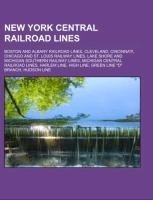
-
 Anglický jazyk
Anglický jazyk
New York Central Railroad lines
Autor: Source: Wikipedia
Source: Wikipedia. Pages: 28. Chapters: Boston and Albany Railroad lines, Cleveland, Cincinnati, Chicago and St. Louis Railway lines, Lake Shore and Michigan Southern Railway lines, Michigan Central Railroad lines, Harlem Line, High Line, Green Line "D"... Viac o knihe
Na objednávku, dodanie 2-4 týždne
14.70 €
O knihe
Source: Wikipedia. Pages: 28. Chapters: Boston and Albany Railroad lines, Cleveland, Cincinnati, Chicago and St. Louis Railway lines, Lake Shore and Michigan Southern Railway lines, Michigan Central Railroad lines, Harlem Line, High Line, Green Line "D" Branch, Hudson Line, West Side Line, Beacon Line, Grand Junction Railroad and Depot Company, St. Lawrence Subdivision, Charlotte Running Track, Mohawk Subdivision, Porter Subdivision, Rochester Subdivision, Hudson Subdivision, Selkirk Subdivision, Dayton District, Montreal Subdivision, Boston Subdivision, Lockport Subdivision, Berkshire Subdivision, St. Louis Line Subdivision, Post Road Branch, Niagara Subdivision, Short Line Subdivision, Erie West Subdivision, Windsor Subdivision, River Subdivision, Cleveland Terminal Subdivision, Columbus Line Subdivision, Lake Shore Subdivision, Detroit Line, Castleton Subdivision, West Shore Subdivision, Schodack Subdivision, Bergen Subdivision, Carman Subdivision, Belt Subdivision. Excerpt: Metro-North's Harlem Line, originally chartered as the New York & Harlem Railroad, is an 82-mile (132 km) commuter rail line running north from New York City into eastern Dutchess County. The lower 53 miles (86 km) from Grand Central Terminal to Southeast, in Putnam County, are electrified with a third rail and has two (or more) tracks; north of that point, trains use diesel locomotives on a single track. The diesel trains run as a shuttle on the northern end of the line except during rush hours, when they run as expresses to or from Grand Central. There is also one direct roundtrip to Grand Central on weekends. While the line has traditionally served to bring commuters from Westchester County to jobs in the city, in recent years it has begun to see more "reverse commuting", as Bronx residents use it to reach jobs in Southern Westchester where many stations are within walking distance of city centers. The northern reaches of the line are also close enough to Western Massachusetts to enable residents of part of that region to commute to jobs in the city as well, albeit at a considerable expense in time and money. With 38 stations, the Harlem Line has the most of any Metro-North main line. Its northern terminal, Wassaic, is the northernmost station in the system. It is the only Metro-North line used exclusively by that carrier (no use by Amtrak, though CSX services freight customers as far north as Mount Vernon) and the only one that uses the entirety of existing track. Metro-North has assigned it the color code blue, used as trim on station signs and spot color on printed timetables. The blue color-coding appears to have started with timetables issued by predecessor New York Central as far back as 1965. Prior to becoming part of the Metro-North system, the line continued all the way north to Chatham, New York on the Boston and Albany Railroad, about 52 miles past the current terminal at Wassaic. Passenger service from Dover Plains to Chatham was abandoned in 1972, a
- Vydavateľstvo: Books LLC, Reference Series
- Rok vydania: 2020
- Formát: Paperback
- Rozmer: 246 x 189 mm
- Jazyk: Anglický jazyk
- ISBN: 9781157116783


 Nemecký jazyk
Nemecký jazyk 








